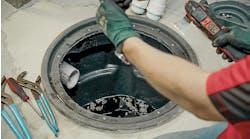Last month I was reminded of the importance of education. I’ve always believed education plays a pivotal role in shaping an individual. Education and experiences create knowledge, and even sometimes wisdom, and it opens up different doors and paths one can take in life.
Al Schwartz, one of Contractor’s monthly columnists, hit a note for me with his column about education reaching critical mass. His column reminded me of my experiences when I went back to school full-time, when I was living in Michigan, to become a teacher. I wanted to teach journalism and English at the secondary level. Unfortunately, elective courses such as journalism along with art, music, and many vocational courses were on the chopping block, and not only because of school districts being cash strapped, but also because the state decided to increase high school graduation requirements, which I’m completely for, but not to such an extreme.
These college prep standards all students need to meet are making all students go the same route regardless of their interests and abilities. Plus, as Schwartz states in his column, “There are many students who like to work with their hands or who have an interest in the construction industry, but the powers that be consider such “blue collar” calling beneath their notice and tacitly, or actively discourage it.”
From my experience in the teaching program, I do think increasing graduation requirements to an extreme is doing a disservice to certain career paths, such as the construction trades. I’m thankful I had the flexibility and option to take different courses, not all college prep, when I was in high school. Based on my student teaching and observation in Michigan secondary schools, I get the feeling that there is not as much flexibility in the school systems as when I was in high school, which is a shame. Education at all levels should progress, not freeze or go backwards.
In TIME magazine, the article “Learning That Works” by Joe Klein states, “The education establishment’s response to the voc-ed problem only made things worse. Over time, it morphed into the theology that every child should go to college and therefore every child should be required to pursue a college-prep course in high school. The results have been awful.”
The article notes that most high school graduates are not prepared for the world of work, unemployment rate for high school graduates not in school is 33%; four-year colleges graduate only about 40% of the students who start them; and two-year community colleges gradate about less than that, about 23%.
Students simply are not being prepared for the world outside of high school, whether it’s trade school, a two-year community college, or a four-year college.
According to John Huppenthal, Arizona’s state education superintendent, quoted in the article, CTE (Career and Technical Education) is essential for a world-class education.
“Most students respond better to a three-dimensional learning process,” he states. It’s easier to learn engineering by actually building a house … than sitting in a classroom figuring out the process in the abstract. Some students respond to two-dimensional learning, but most respond better when it’s hands on.”
Hands on learning is exactly what I saw when I went to Bozeman, Mont., to check out REHAU’s and the MSU (Montana State University) Creative Research Lab’s (CRLab) ecosmart house, a residential modeling and construction project exhibiting the possibilities of maximized energy efficiency and occupant comfort through a combination of the latest sustainable building products and systems.
This project is extra ordinary for a handful of reasons, but one of the neatest aspects of the home is that students from a multitude of schools, the School of Architecture, the College of Engineering, the College of Business, and the School of Film and Photography, at MSU have worked on this project, obtaining real-world experience and seeing how collaboration amongst building industry professionals is key to designing and constructing a project. Approximately 20 to 30 MSU students will have worked on this project once it is completed.
I’m sure Huppenthal would love this project since it’s the perfect example of what he believes… that many students learn better when they learn hands on.
“It is great to see students so engaged in this project,” said Terry Beaubois, director of the CRLab. “Often there is a disconnect between reality and academia. On this project students from different disciplines were involved, even business students. You see the students light up with the knowledge they gain and how they are able to communicate it. Students used critical thinking skills to think their way through this project. The actual methodology was collaboration.”
According to Beaubois, students working on this project will know how to work collaboratively and on teams, which is how the real-world works, giving them an advantage.
Students from the CRLab have helped with the design and mechanical systems of the home. For example, mechanical engineering students, under the guidance of Professor Kevin Amende, have worked on the computer modeling of heating and cooling air exchanges and the effectiveness of different building supplies in the area’s climate. They will now run tests on the house for two years to study the effectiveness of the different technologies and products in the home. This gives students a hands-on learning experience that would not be possible to obtain in a classroom or lab.
Since Beaubois and Amende collaborate well with each other while working on this project, contributing to its success, this also sets an example for students to see academic collaboration in action.
Visiting Montana State University and the ecosmart house brought me back to my days at Michigan State University. Even though I was not studying architecture or construction trades, I did excel in and enjoy what I considered hands-on learning. My favorite classes were journalism and PR courses that were not taught in a classroom, but in the real world. I learned more and gained more knowledge by going out of the classroom to research and writing articles about local events for journalism classes and meeting with real-world clients for public relation courses. This thought also takes me back to high school … I wasn’t in a vocational program, but I learned so much from my journalism classes and writing for the weekly student newspaper. Without those experiences while a student, who knows if I would be doing what I’m doing right now.
All in all, the K-12 system and post-secondary institutions need to add more hands-on learning experiences, regardless of the specialty being taught. This connects academics to reality, something that is missing from so much K-12 curricula and post-secondary programs.

